The first time I used a quick release socket it was a revelation. I had seen the notch set up for them, but not the adapter. For me being able to replace a bit, or use multiple bits, and not have them fall out at the first opportunity was wonderful.
Since then I have sought the perfect one. Perfect may not be possible, but there are two of them that make me happy. One is an adapter, and one is a creation of my own.
The best adapter currently available is the Taper Lock by FastCap. The red ones in the picture above are all Taper Locks. I like them enough to have several.
Before I found the Taper Locks, I preferred the inexpensive but now unobtainable HF blue thin quick releases. Apart from the wobble, which is less than all but the Taper Locks, it is as good as any that I have tried. The one with the green stripe in the picture above is the Wera Rapidapter. Despite the praise and respect it gets, it wobbles in the stem and the socket. It is pricy without being anything to brag about.
There is another charming flaw to the blue HF sockets. When you pull back an release a bit, it will fire several feet. Funny, until a tool rolls under something.
Some expensive sockets will not let go of a tool, several are just plain large.
The Taper Lock has the great advantage of grabbing onto a tool tight, and if you snug it back on a tool, you can eliminate wobble completely. It will do this with a smooth shaft just as well as it will one with a quick release indention.
My older screwdrivers are still great, but they were made before my research informed me that tools terminating in your palm are more likely to cause debilitating injuries.
Having an adapter that locks down tight presents a few very interesting options. Handles take up space. The awl, chip carving knives and the birdcage awl all take up a lot more room than just their blade does.
But when a chisel bit can be used because the socket is secure suddenly a small chisel becomes smaller and less expensive for a high grade tool.
With a Skewed Octagonal Handle, a simple sheepsfoot blade becomes a chip knife.
The skew and the cowl over the blade makes this horrible for driving screws, but for blades, this is a superior grip despite being interchangeable. The cowl over the blade gives a nice area so you can apply pressure right where you are cutting, without coming in contact with the blade.
Your thumb or your finger can apply pressure right over the cut with safety and a more comfortable position.
The tool range on a nice hex tool was already amazing, but when you add knives and chisels it gets much larger.
Here is a simple bit collection.
Normal Blade
Drop Point Blade
Sheepsfoot Blade
Skew Blade
Detail Blade
Fur Carving Blade
V-Gouge
Gouge
1/16″ Chisel
1/8″ Chisel
1/4″ Chisel
Awl
Birdcage Awl
Birdcage Screw Starter
The clumsily made but effective Birdcage Screw Starter was made to match a screw size that I use a lot of.
It is a lot sturdier than your normal screw starter, does not clog with sawdust and works just as fast in a power tool as the expensive and fragile bits you normally use for the job. This also works by hand, so there is no downside to this.
So apart from the lack of a ratchet, this hexagonal screwdriver will grab any 1/4″ hex bit, hold it tight and release it when I want it to. As a result, I believe that I have in my tool box one of the best and most useful screwdrivers in the world. Mwwa Haa Haa Haa!
There is one serious downside I have found to the Taper Lock. If you are grinding steel, you can produce a lot of iron filings that will bed in your fingers and stick to tools. The mechanism on the Taper Lock will become almost unworkable after it gets filled with these tiny bits of magnetic steel.
With a degausser and a rare earth magnet, this problem can be eliminated, but the Taper Lock should probably not be used in a machinists environment.
Fortunately I keep a rather nice degausser handy.
I have only begun to make the range of tools and blades that this enables. The fun part is being able to have an extensive fine detail carving kit that fits in your pocket. If a large set of these blades was to be mass produced, how nifty would it be to be able to cheaply obtain a really nice carving set with chip knives, chisels, gouges, veiners and the like.
FastCap, the company that produces the Taper Lock is not interested in producing such a set, and there is no real point in these tools if you don’t have a socket that is stable. So I started playing around with making my own hex sockets. My set screw and thumbscrew versions are functional, but I wanted better.
If you want to grind a few bits on your own, it is good to let the color shift to amber, the tool will be easier to sharpen. Don’t let the color drift further into blue. If you clean your bits well and make sure to get the iron bits washed off your hands and the tool bit, the FastCap socket holder will work great with it and you won’t have to build your own.
Here is the bit holder that I came up with. It is a really fast collet system where a shaft with a 1/4″ hex collet on the end. By pulling the big knob back into the handle, the collet locks onto the tool bit solidly. I like to rotate it a touch as I lock and unlock the bit.
by pushing the ball with one hand while guiding with the handle in the other hand, this turned out to be a very controllable and comfortable tool. As well as being rather pretty. A ball end does have the issue of terminating in the palm, but as I am using it, it is more comfortable to have it gripped and not pushed by the flat of the palm.
This one had an aluminum shaft, but no collar apart from the grip. IIt worked great, flawless really. But because it did not have a metal collar, the wood was worn down a bit every time I engaged the collet. It was clear that this tool was going to have a short life unless I put a metal collar on it.
Because it was a ‘quick’ prototype and I wanted to test it, I used a commonly available wooden ball with a socket in it for the handle. I planned to make another shape, but the balls size, mass, and grip worked out so well that I hate to change it. So considering how to adjust the initial form, I made another collet, this time in bronze. I am not sure what bronze this is, I got it at a welding supply many years ago, but it tested negative for lead, so I am happy to use it.
Previously I detailed how to cut a hexagonal hole into wood. I started doing this when I was making my carving gauges. Aluminum was a bit more challenge, and bronze needed even more work. But the basic methods are the same.
In the picture above you can see where I made bevel leading to the main hole to start, and cut one groove for lining up the hex cutter as I rotated it. The hexagonal corners are only half down to depth in this picture.
Most of the work is getting the cutter extracted from the hole when it jams in.
I did not want to go any deeper than I had to so I compared depth regularly.
Then I went back to pounding the cutter in, working it out and then rotating it and pounding it in again.
After this was done, sawing the slits to make it a collet was easy.
All the hard work was worth it and the result pleased me so much that I made a second one out of bronze. Since I had already made all the tools I needed for this and knew what I was doing, it went quite a bit faster. now I have two wonderful bit drivers and the tool I used the prototype to make. The bronze bling is entirely justified and even required for this tool, and the final effect is as authentically steam punk as you could possibly want.
The saw in the picture below was made using this tool. I used it with the 1/8″ mortise chisel bit shown in the bottom bit chuck driver and with a sheepsfoot bit to clean the sides of the channel. I also used a square profile scraper bit to clean the bottom and sides up.
Here are the same tools, but the middle one has the ball pushed forward to release the bit.
I am still working on the skew version of this handle like I have using the Taper Lock. This is needed for making the ideal interchangeable knife, but that will probably need to be more of the classic threaded collet.
Till then I will have to get by with this small collection of handmade drivers, The three ground down bits together in the glare at about 11:00 in the picture are the tools I used to make the hexagonal collet.
Click on the image for a better view!
While I really try to encourage people to make their own tools, this tool set requires a bit of special tooling and equipment to make. So unless I find a company that wants to work with me to put this one out, I will probably make a few of these to sell.
Bob


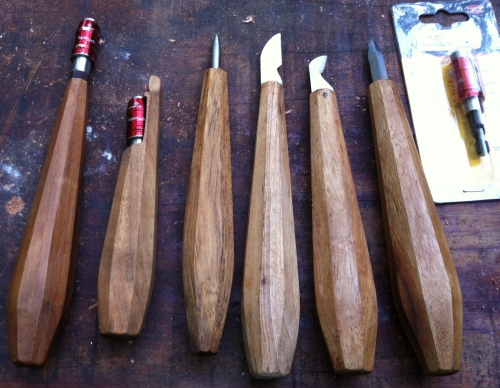

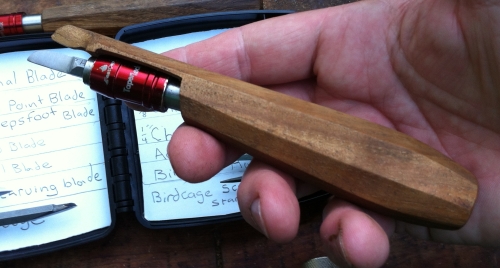

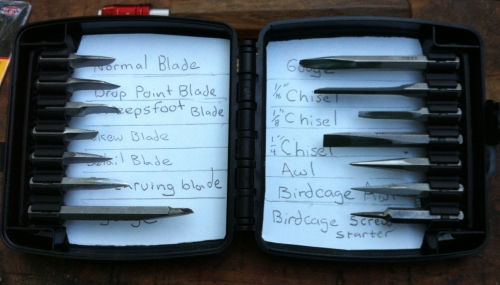


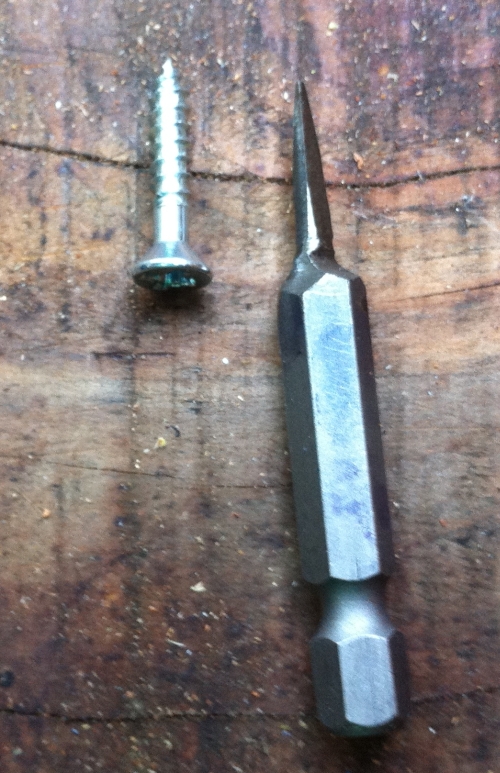
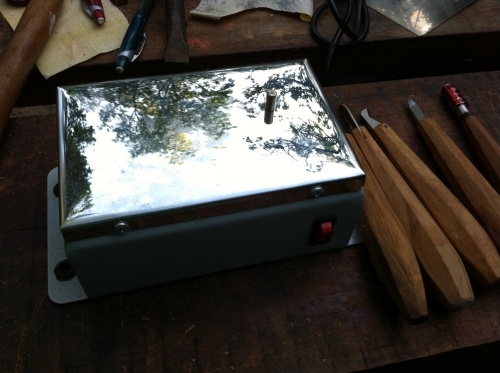
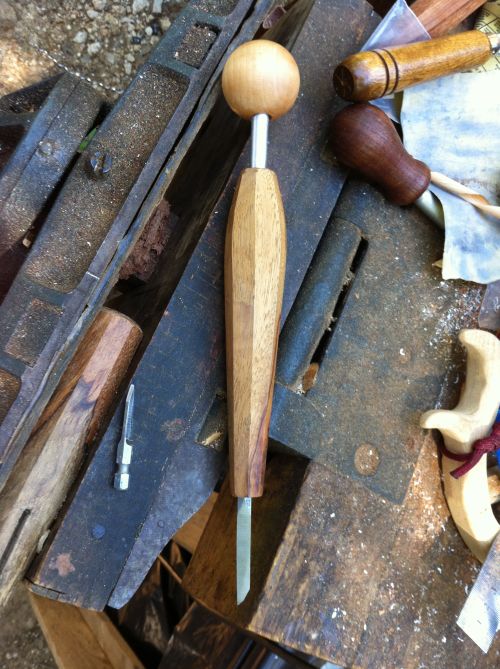



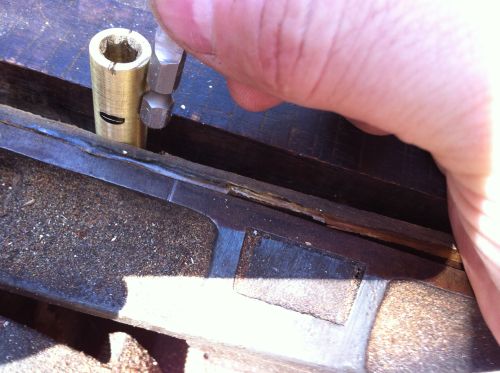

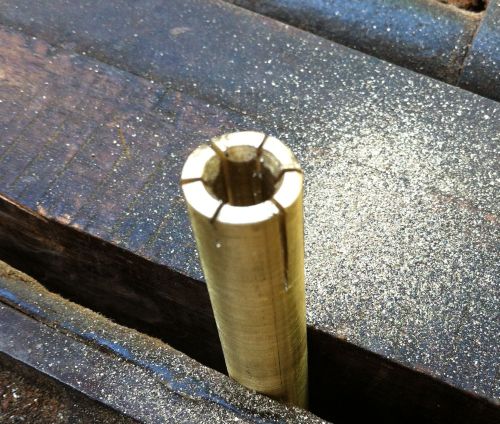
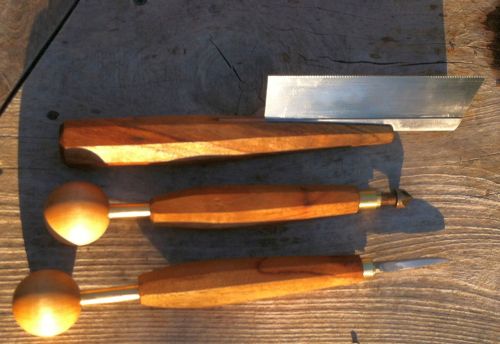
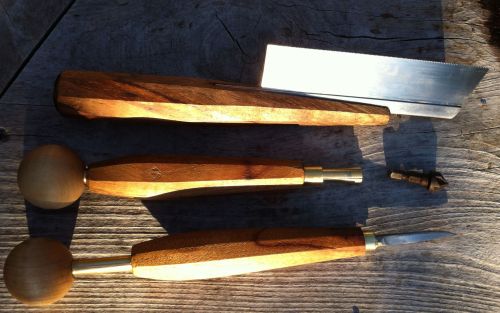
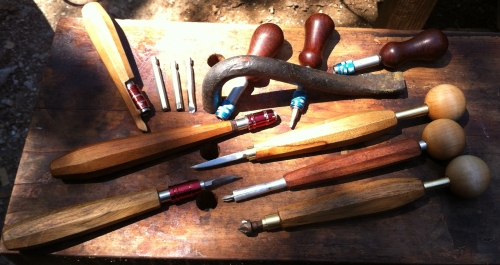
 A page Dedicated to My Writing
A page Dedicated to My Writing
Bob, this is very cool!
Do you find it much different than your other tools using the taper lock, or did you make it just to avoid the problem with the magnetic filings?
Have you run into any problems pushing on the ball and releasing the bit while working?
I think having an easily transported detail carving system that does not consist of a bunch of flimsy tools on tiny handles is a really cool thing to have. My dream would be that a company would come along and offer me 3 percent share of the profits for handle and tool designs. The Taper Lock would do the job with no problem, but no company is going to want to make a set of bits that require a bit holder made by someone else. So I had to come up with a solid handle or my tool idea will remain unique to me. As it is, there are companies that will make custom bits for you if you are willing to order a thousand at a time. I am tempted to try and put this up on http://www.kickstarter.com/ and seeing if there is enough interest.
As far as it releasing while working, it did it twice as I was learning to use it and then I had no problems. If you pull back on the handle it may release on you. I think that if I used a mallet on the end it will release as well. It takes a moment to learn, but after learning, it is really fast convenient and solid. This was a relatively quick test of concept that ended up needing very little modification to turn it into a first class tool.
I will be making more of these, but first I need to make a few wooden spigots for my wife. She has been making kombucha, ginger beer and vinegar lately and needs a few to support her projects.
Bob
Aah, that makes sense. It seems like a great idea to me, especially your carving kit idea. I bet you could get 100 orders without too much trouble, but 1000 sounds like a lot, especially with all the options you’re looking at.
Do you think it would be possible to replace the push/pull ball end with a twisting lock, or is that what you started with before coming on to this design?
I think your are probably right about demand, Shaun. If I grind the bits myself I could still turn out a few, but it would get tiresome quickly and the price would make them more like collectors items than tool sets.
As far as threading the collet goes, My original intent was to put threads on it and the collar. Instead of having the collar tighten down on the collet from the front, I wanted to reverse this and have the collet itself turn in the collar. This would reduce the size of the front end and put your hand further away from the bit when you are removing it. Trying to turn a fine collet that is locked down hard, when a sharp tool is in it can be bad.
While I was initially working the shape of it on my lathe, the dead center I was using locked into the Morse taper on the lathe in a very stubborn way. Morse tapers lock solid without threads. Most lathes, mills, drill presses and the like lock down tools, chucks and centers with a simple tapered cone pushed into a tapered hole.
I decided to test the concept with a fine taper and a big handle for securing and releasing tools. The result is a simpler, more reliable and more wear resistant system.
For the skew handle, I think I will have to make it threaded, since the large knob at an angle would be a problem and I don’t want a separate key to draw the taper in and remove it. The taper is working so well without threads, that I am turning methods over in my mind trying to come up with a way. I am almost tempted to try a version where the locking collet is tapped in and out like you do a blade on a wooden plane.
Bob
You know, I would totally be the first one to slice up my hand trying to tighten a blade down.
Have you tried putting a cowl on a straight handle? Something removable might give you some of the benefits of the screw handle as well as what you have now, though it also might jus turn a great tool into a terrible one (I’m good at ideas that do that).
Otherwise, I’ve been trying to think of ways to improve on you push/pull ball with the skew handle and I’m coming up with nothing.The locking method used with Opinel knives might work, but I have had problems with mine staying locked ocassionally. The veritas carvers knife also seems to gave a similar idea, though not using hex bits so it probably won’t help. Good luck figuring it out!
I am thinking that if I thread the shaft and have a slot in the body for a large knurled nut, I can use that to drive the collet in and out. I am pretty sure that will work and eliminate the screw at the front and the knob at the back. It won’t be a fast as the knob is, but it still should be safe and quick enough. Now I need to come up with a proper old fashioned name for the tool. 🙂
Your idea of a cowl on a straight one might just be a brilliant answer as well. For that matter, a detachable cowl that altered the grip shape might work. The original tool form would have to be lightened and shortened a bit, but it might just do.
Bob
Looking forward to seeing the next version, I love these kind of things.